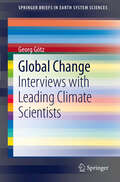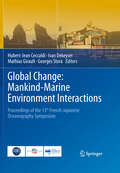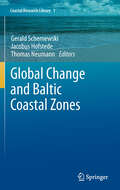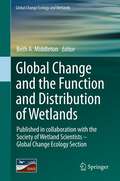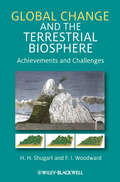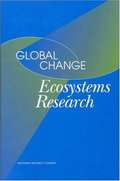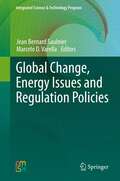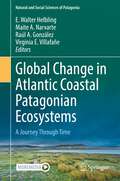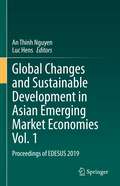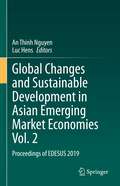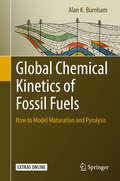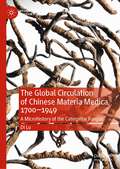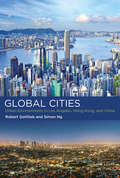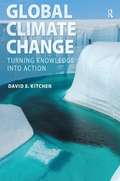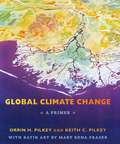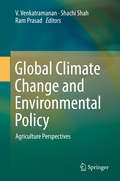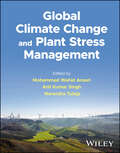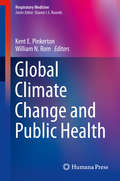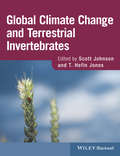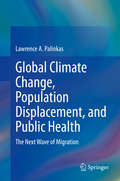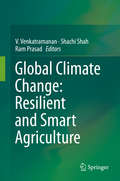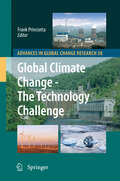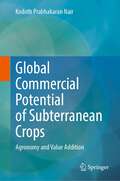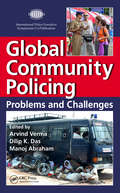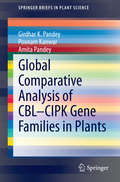- Table View
- List View
Global Change
by Georg GötzSeven interviews with leading climate scientists cover both fundamental research (climate modeling, global warming, sea level change, melting of the ice caps, natural hazards) and impact assessment (adaption, mitigation, economic impacts and costs of climate change). Experts on different aspects of the topic explain their own field and give their opinion on general questions concerning climate change. The goal is to provide the reader with first-hand information on the current state of climate research.
Global Change: Mankind-Marine Environment Interactions
by Georges Stora Hubert-Jean Ceccaldi Ivan Dekeyser Mathias GiraultBased on the material presented at a conference organized by the Centre d'Océanologie of Marseille, held in 2008, this text covers a wealth of hot topics related to the way mankind interacts with the marine environment. With the state of our oceans and seas becoming an increasing source of concern worldwide, this timely addition to the debate features the latest research in both France and Japan. The book's chapters present work on many of the key areas of oceanographic study. The concept of marine biodiversity is treated, in particular how it is affected by human agency and invasive species, many of which have been introduced anthropogenically. Coastal zones are analyzed in detail, with a focus on the interaction between ports and natural environments, and the ecological and economical consequences of this relationship. A chapter on aquaculture looks at ecologically sound management as well as the preservation of resources. New and emerging technologies that aid our observation of the marine environment are covered, as is the physical, chemical, biological and biogeochemical functioning of natural and man-made environments. Featuring work by some of the leading researchers in the field from both France and Japan, this work demonstrates the strength of the links between the two scientific communities, and is an important contribution to the ongoing discussion on the effects of global warming as well as mankind's impact on the marine environment we depend on for so much.
Global Change and Baltic Coastal Zones
by Gerald Schernewski Jacobus Hofstede Thomas NeumannClimate change and ongoing transformation processes in economy and agriculture will have strong and multiple impacts in the Baltic region. In particular coastal zones face increasing hazards, e.g. due to sea level rise or changes in riverine nutrient loads and eutrophication. These changes also offer a wide range of new opportunities in the Baltic Region. Adaptation measures are needed but require a thorough and spatially differentiated understanding of underlying ecological, economic and social processes. Sixteen contributions by authors from eight countries give a comprehensive overview of these changes, their consequences and practical challenges with focus on coastal zones. Besides risks, the chances and opportunities of changes for the region are addressed and adaptation examples and strategies are given. The practitioners' perspective and their demands are integrated in the various contributions.
Global Change and the Function and Distribution of Wetlands
by Beth A. MiddletonThe Global Change Ecology and Wetlands book series will highlight the latest research from the world leaders in the field of climate change in wetlands. Global Change and the Function and Distribution of Wetlands highlights information of importance to wetland ecologists. The chapters include syntheses of international studies on the effects of drought on function and regeneration in wetlands, sea level rise and the distribution of mangrove swamps, former distributions of swamp species and future lessons from paleoecology, and shifts in atmospheric emissions across geographical regions in wetlands. Overall, the book will contribute to a better understanding of the potential effects of climate change on world wetland distribution and function.
Global Change and the Terrestrial Biosphere: Achievements and Challenges
by H. H. Shugart F. I. WoodwardGlobal climate change challenges ecologists to synthesize what we know to solve a problem with deep historical roots in our discipline. In ecology, the question, “How do terrestrial ecosystems interact with the other earth systems to produce planetary change?” has sufficient depth to be the focal challenge. This central question is sharpened further as the changes that we may be manifesting upon our planet’s systems of land, sea, air and ice can have potential consequences for the future of human civilization. This book provides the depth of the history of global ecology and reviews the breadth of the ideas being studied today. Each chapter starts with a brief narrative about a scientist whose work traces forward into today’s issues in global ecosystems. The discussions are framed in a growing realization that we may be altering the way our planet functions almost before we have gained the necessary knowledge of how it works at all.
Global Change Ecosystems Research
by Ecosystems PanelThe National Academies Press (NAP)--publisher for the National Academies--publishes more than 200 books a year offering the most authoritative views, definitive information, and groundbreaking recommendations on a wide range of topics in science, engineering, and health. Our books are unique in that they are authored by the nation's leading experts in every scientific field.
Global Change, Energy Issues and Regulation Policies
by Marcelo D. Varella Jean Bernard SaulnierThis book analyses the deep interaction between the world's environmental crises, energy production, conversion and use, and global regulation policies. Bringing together experts from a wide range of scientific fields, it offers the reader a broad scope of knowledge on such topics as: climate change and exhaustion of resources the relationship between basic science and the development of sustainable energy technologies the relationship between global and local environmental policiesthe possible competition between foodstuff production and that of agro-fuels urban adaptation negotiations at the international level financial rules This book invites the reader to consider the multidisciplinary aspects of these urgent energy/environmental issues.
Global Change in Atlantic Coastal Patagonian Ecosystems: A Journey Through Time (Natural and Social Sciences of Patagonia)
by E. Walter Helbling Virginia E. Villafañe Maite A. Narvarte Raúl A. GonzálezThis book provides an integrated view of Atlantic coastal Patagonian ecosystems, including the physical environment, biodiversity and the main ecological processes, together with their derived ecosystem services and anthropogenic impacts. It focuses on the key components of the aquatic ecosystem, covering the lower levels (plankton) to the top predators like large mammals and birds, before turning to human beings as consumers and shapers of coastal marine resources. The book then presents an overview of how organisms that constitute the aquatic food webs have changed through time and how they likely will soon change due to global change processes and anthropogenic pressures. In this regard it offers a wealth of information such as long-term patterns in physical / atmospheric processes, biodiversity and the distribution of marine organisms, as well as the results of experimental studies designed to understand their responses under future scenarios shaped by both climate change and anthropogenic pressures. The book also covers various aspects of the past, present and potential future relationship of human beings with Patagonian coastal environments, including the utilization of sea products, tourism, and growth of cities.
Global Changes and Sustainable Development in Asian Emerging Market Economies Vol. 1: Proceedings of EDESUS 2019
by An Thinh Nguyen Luc HensThis two-volume set presents the conference papers from the 1st International Conference on Economics, Development and Sustainability (EDESUS 2019), organized by the University of Economics and Business, Vietnam National University, Hanoi. The collection addresses global changes and sustainable development in Vietnam and other emerging market economies in Asia, and covers wider topics such as economics and business (e.g. economic theory, national and international income distribution, macroeconomic policies, sectors of economy, productivity developments, financial market, business governance, bank financing), development and sustainability (e.g. developing process, development policy, public policy, sustainable growth, sustainability tools, sustainable livelihood, sustainable tourism, green growth), and resources and global change (e.g. human resources, natural resources, climate change, globalization, global challenges). The books are of interest to professors, researchers, lecturers, and students in economics and geography, consultants, and decision makers interested in global changes and sustainable development. Volume 1 focuses on economic development in Vietnam and other emerging market economies in Asia. This covers topics such as economics and business (e.g. economic theory, national and international income distribution, macroeconomic policies, sectors of economy, productivity developments, financial market, business governance, bank financing) and development studies (e.g. developing process, development policy, public policy, green growth).
Global Changes and Sustainable Development in Asian Emerging Market Economies Vol. 2: Proceedings of EDESUS 2019
by An Thinh Nguyen Luc HensThis two-volume set presents the conference papers from the 1st International Conference on Economics, Development and Sustainability (EDESUS 2019), organized by the University of Economics and Business, Vietnam National University, Hanoi. The collection addresses global changes and sustainable development in Vietnam and other emerging market economies in Asia, and covers wider topics such as economics and business (e.g. economic theory, national and international income distribution, macroeconomic policies, sectors of economy, productivity developments, financial market, business governance, bank financing), development and sustainability (e.g. developing process, development policy, public policy, sustainable growth, sustainability tools, sustainable livelihood, sustainable tourism, green growth), and resources and global change (e.g. human resources, natural resources, climate change, globalization, global challenges). The books are of interest to professors, researchers, lecturers, and students in economics and geography, consultants, and decision makers interested in global changes and sustainable development. Volume 2 focuses on global changes and sustainable development in Vietnam and other emerging market economies in Asia. This covers topics such as sustainability (e.g. sustainable growth, sustainability tools, sustainable livelihood, sustainable tourism), and change in resources globally (e.g. human resources, natural resources, climate change, globalization, global challenges).
Global Chemical Kinetics of Fossil Fuels
by Alan K. BurnhamThis book covers the origin and chemical structure of sedimentary organic matter, how that structure relates to appropriate chemical reaction models, how to obtain reaction data uncontaminated by heat and mass transfer, and how to convert that data into global kinetic models that extrapolate over wide temperature ranges. It also shows applications for in-situ and above-ground processing of oil shale, coal and other heavy fossil fuels. It is essential reading for anyone who wants to develop and apply reliable chemical kinetic models for natural petroleum formation and fossil fuel processing and is designed for course use in petroleum systems modelling. Problem sets, examples and case studies are included to aid in teaching and learning. It presents original work and contains an extensive reanalysis of data from the literature.
The Global Circulation of Chinese Materia Medica, 1700–1949: A Microhistory of the Caterpillar Fungus (Medicine and Biomedical Sciences in Modern History)
by Di LuThis book explores the dissemination of knowledge around Chinese medicinal substances from the eighteenth to twentieth centuries in a global context. The author presents a microhistory of the caterpillar fungus, a natural, medicinal substance initially used by Tibetans no later than the fifteenth century and later assimilated into Chinese materia medica from the eighteenth century onwards. Tracing the transmission of the caterpillar fungus from China to France, Britain, Russia and Japan, the book investigates the tensions that existed between prevailing Chinese knowledge and new European ideas about the caterpillar fungus. Emerging in eighteenth and nineteenth-century Europe, these ideas eventually reached communities of scientists, physicians and other intellectuals in Japan and China. Seeking to examine why the caterpillar fungus engaged the attention of so many scientific communities across the globe, the author offers a transnational perspective on the making of modern European natural history and Chinese materia medica.
Global Cities: Urban Environments in Los Angeles, Hong Kong, and China (Urban and Industrial Environments)
by Robert Gottlieb Simon NgHow Los Angeles, Hong Kong, and China deal with such urban environmental issues as ports, goods movement, air pollution, water quality, transportation, and public space.Over the past four decades, Los Angeles, Hong Kong, and key urban regions of China have emerged as global cities—in financial, political, cultural, environmental, and demographic terms. In this book, Robert Gottlieb and Simon Ng trace the global emergence of these urban areas and compare their responses to a set of six urban environmental issues.These cities have different patterns of development: Los Angeles has been the quintessential horizontal city, the capital of sprawl; Hong Kong is dense and vertical; China's new megacities in the Pearl River Delta, created by an explosion in industrial development and a vast migration from rural to urban areas, combine the vertical and the horizontal. All three have experienced major environmental changes in a relatively short period of time. Gottlieb and Ng document how each has dealt with challenges posed by ports and the movement of goods, air pollution (Los Angeles, Hong Kong, and urban China are all notorious for their hazardous air quality), water supply (all three places are dependent on massive transfers of water) and water quality, the food system (from seed to table), transportation, and public and private space. Finally they discuss the possibility of change brought about by policy initiatives and social movements.
Global Climate Change: Turning Knowledge Into Action
by David KitchenThis book examines what scientists know about global warming and climate change and considers political and economic solutions that will balance the competing needs of people around the world.
Global Climate Change: A Primer
by Orrin H. Pilkey Keith C. PilkeyAn internationally recognized expert on the geology of barrier islands, Orrin H. Pilkey is one of the rare academics who engages in public advocacy about science-related issues. He has written dozens of books and articles explaining coastal processes to lay readers, and he is a frequent and outspoken interviewee in the mainstream media. Here, the colorful scientist takes on climate change deniers in an outstanding and much-needed primer on the science of global change and its effects. After explaining the greenhouse effect, Pilkey, writing with son Keith, turns to the damage it is causing: sea level rise, ocean acidification, glacier and sea ice melting, changing habitats, desertification, and the threats to animals, humans, coral reefs, marshes, and mangroves. These explanations are accompanied by Mary Edna Fraser's stunning batiks depicting the large-scale arenas in which climate change plays out. The Pilkeys directly confront and rebut arguments typically advanced by global change deniers. Particularly valuable are their discussions of "Climategate," a manufactured scandal that undermined respect for the scientific community, and the denial campaigns by the fossil fuel industry, which they compare to the tactics used by the tobacco companies a generation ago to obfuscate findings on the harm caused by cigarettes.
Global Climate Change and Environmental Policy: Agriculture Perspectives
by V. Venkatramanan Shachi Shah Ram PrasadGlobal climate change threatens human existence through its potential impact on agriculture and the environment. Agriculture is climate-sensitive, and climate variability and climate change have net negative impact on it. Additionally, the agricultural landscape is affected by monoculture and agro-biodiversity loss, soil fertility depletion and soil loss, competition from biofuel production, crop yield plateaus and invasive species. Nevertheless, the global agricultural production system has to meet the food demands from the growing human population, which is set to exceed 10 billion by 2050. This book discusses the impacts of climate change on agriculture, animal husbandry and rural livelihoods. Further, since agriculture, forestry and other land-use sectors contribute about 10–12 gigatonnes of CO2-equivalent per year, it argues that agricultural policy must dovetail adaptation and mitigation strategies to reduce greenhouse gases emissions. This calls for a reformative and disruptive agricultural strategy like climate-smart agriculture, which can operate at all spatio-temporal scales with few modifications. The book also redefines sustainable agriculture through the lens of climate-smart agriculture in the context of the sustainability of Earth's life- support system and inter- and intra-generational equity. The climate-smart agriculture approach is gaining currency thanks to its inherent positive potential, and its goal to establish an agricultural system which includes "climate-smart food systems", "climate-proof farms", and "climate-smart soils". Climate-smart agriculture provides a pathway to achieve sustainable development goals which focus on poverty reduction, food security, and environmental health.
Global Climate Change and Plant Stress Management
by Narendra TutejaGlobal Climate Change and Plant Stress Management Understand the impact of climate change on plant growth with this timely introduction Climate change has had unprecedented consequences for plant metabolism and plant growth. In botany, adverse effects of this kind are called plant stress conditions; in recent years, the plant stress conditions generated by climate change have been the subject of considerable study. Plants have exhibited increased photosynthesis, increased water requirements, and more. There is an urgent need to understand and address these changes as we adapt to drastic changes in the global climate. Global Climate Change and Plant Stress Management presents a comprehensive guide to the effects of global climate change on plants and plant metabolism. It introduces and describes each climate change-related condition and its components, offering a detailed analysis of the resulting stress conditions, the environmental factors which ameliorate or exacerbate them, and possible solutions. The result is a thorough, rigorous introduction to this critical subject for the future of our biome. Readers will also find: Analysis of global climate change impact on various agricultural practices Socio-economic consequences of climate change and plant stress conditions, and possible solutions Strategies for sustainable agriculture Global Climate Change and Plant Stress Management is essential for researchers, scientists, and industry professionals working in the life sciences, as well as for advanced graduate students.
Global Climate Change and Public Health
by Kent E. Pinkerton William N. RomPulmonary physicians and scientists currently have minimal capacity to respond to climate change and its impacts on health. The extent to which climate change influences the prevalence and incidence of respiratory morbidity remains largely undefined. However, evidence is increasing that climate change does drive respiratory disease onset and exacerbation as a result of increased ambient and indoor air pollution, desertification, heat stress, wildfires, and the geographic and temporal spread of pollens, molds and infectious agents. Preliminary research has revealed climate change to have potentially direct and indirect adverse impacts on respiratory health. Published studies have linked climate change to increases in respiratory disease, including the following: changing pollen releases impacting asthma and allergic rhinitis, heat waves causing critical care-related diseases, climate driven air pollution increases, exacerbating asthma and COPD, desertification increasing particulate matter (PM) exposures, and climate related changes in food and water security impacting infectious respiratory disease through malnutrition (pneumonia, upper respiratory infections). High level ozone and ozone exposure has been linked to idiopathic pulmonary fibrosis, lung cancer, and acute lower respiratory infection. Global Climate Change and Public Health is an important new volume based on the research, findings, and discussions of US and international experts on respiratory health and climate change. This volume addresses issues of major importance to respiratory health and fills a major gap in the current literature. The ATS Climate Change and Respiratory Health Workshop was held in New Orleans, Louisiana, on May 15, 2010. The purpose of the meeting was to address the threat to global respiratory health posed by climate change. The workshop was attended by domestic and international experts as well as representatives of international respiratory societies and key US federal agencies. Dr. Pinkerton and Dr. Rom, the editors of this title, were co-chairs of the Climate Change Workshop and Symposium.
Global Climate Change and Terrestrial Invertebrates
by Scott N. Johnson T. Hefin JonesInvertebrates perform such vital roles in global ecosystems—and so strongly influence human wellbeing—that biologist E.O. Wilson was prompted to describe them as “little things that run the world.” As they are such powerful shapers of the world around us, their response to global climate change is also pivotal in meeting myriad challenges looming on the horizon—everything from food security and biodiversity to human disease control. This book presents a comprehensive overview of the latest scientific knowledge and contemporary theory relating to global climate change and terrestrial invertebrates. Featuring contributions from top international experts, this book explores how changes to invertebrate populations will affect human decision making processes across a number of crucial issues, including agriculture, disease control, conservation planning, and resource allocation. Topics covered include methodologies and approaches to predict invertebrate responses, outcomes for disease vectors and ecosystem service providers, underlying mechanisms for community level responses to global climate change, evolutionary consequences and likely effects on interactions among organisms, and many more. Timely and thought-provoking, Global Climate Change and Terrestrial Invertebrates offers illuminating insights into the profound influence the simplest of organisms may have on the very future of our fragile world.
Global Climate Change, Population Displacement, and Public Health: The Next Wave of Migration
by Lawrence A. PalinkasThis timely text examines the causes and consequences of population displacement related to climate change in the recent past, the present, and the near future. First and foremost, this book includes an examination of patterns of population displacement that have occurred or are currently underway. Second, the book introduces a three-tier framework for both understanding and responding to the public health impacts of climate-related population displacement. It illustrates the interrelations between impacts on the larger physical and social environment that precipitates and results from population displacement and the social and health impacts of climate-related migration. Third, the book contains first-hand accounts of climate-related population displacement and its consequences, in addition to reviews of demographic data and reviews of existing literature on the subject. Topics explored among the chapters include: Hurricane Katrina and New Orleans Hurricane Maria and Puerto Rico The California Wildfires Fleeing Drought: The Great Migration to Europe Fleeing Flooding: Asia and the Pacific Fleeing Coastal Erosion: Kivalina and Isle de Jean Charles Although the book is largely written from the perspective of a researcher, it reflects the perspectives of practitioners and policymakers on the need for developing policies, programs, and interventions to address the growing numbers of individuals, families, and communities that have been displaced as a result of short- and long-term environmental disasters. Global Climate Change, Population Displacement, and Public Health is a vital resource for an international audience of researchers, practitioners, and policymakers representing a variety of disciplines, including public health, public policy, social work, urban development, climate and environmental science, engineering, and medicine.
Global Climate Change: Resilient and Smart Agriculture
by V. Venkatramanan Shachi Shah Ram PrasadThis book provides essential insights into methods and practices of ‘Climate-smart Agriculture,’ which is driven by the principles of climate resilience and smart resource use in agricultural production. Climate-smart agriculture is a key policy instrument for achieving poverty eradication and a hunger-free world, as well as mitigating the effects of climate change. This book discusses in detail climate-smart agricultural technologies and practices that can reduce the vulnerability of agricultural systems, improve the livelihoods of farmers and other stakeholders, and reduce the greenhouse gas emissions from crop production and livestock husbandry. The agriculture, forestry and other land use (AFOLU) sector produces roughly 10–12 gigatons of CO2-equivalent per year; therefore, sustainable practices for agriculture and related land use hold immense potential to mitigate climate change. The potential impacts of climate variability and climate change on agriculture are extensively documented and articulated, especially with regard to global and national environmental agendas that call for innovation, transformation and climate-resilient advances in agriculture. As the book demonstrates, climate-smart agriculture offers an excellent tool for boosting agricultural output to feed the growing global population; for reducing greenhouse gases emissions from agriculture and other land use; and for protecting agricultural production systems from the impending dangers of climate change.
Global Climate Change - The Technology Challenge
by Frank PrinciottaIn order to avoid the potentially catastrophic impacts of global warming, the current 3% CO2 global emission growth rate must be transformed to a 1 to 3% declining rate, as soon as possible. This will require a rapid and radical transformation of the world's energy production and end use systems. The current generation of energy technologies are not capable of achieving the level of mitigation required. Next generations of renewable, low carbon generation and end use technologies will be needed. This book quantifies the mitigation challenge. It then considers the status of key technologies needed to protect the planet from serious climate change impact. Current and emerging technologies are characterized for their mitigation potential, status of development and potential environmental impacts. Power generation, mobile sources, industrial and building sectors are evaluated in detail. The importance and unique challenges for rapidly developing countries, such as China and India are discussed. Current global research and development efforts for key technologies are discussed. It is concluded that it will be necessary to substantially upgrade and accelerate the current worldwide RDD&D effort on both emerging energy technologies and those enabling technologies needed to improve mitigation effectiveness and economics. It will also be necessary to carefully evaluate the potential environmental characteristics of next generation technologies to avoid unacceptable health and ecological impacts. Finally, given the monumental technological challenge associated with transforming the world's energy system, geoengineering options are evaluated, since if successfully deployed, they have the potential to allow more time for the necessary energy system transformation. 'This book on Climate Change not only gives a clear picture of the problem but suggests many of the pitfalls in solving it and recommends strongly, a research program to fill the gaps in our knowledge. It is a most useful reference book for all aspects of the problem.' William D. Ruckelshaus, Madrona Venture Group/Evergreen Venture
Global Commercial Potential of Subterranean Crops: Agronomy and Value Addition
by Kodoth Prabhakaran NairTropical root and tuber crops form an important group of food crops for millions of people (about one-fifth of the world population), especially those living in the tropical and sub-tropical zones. Tuber crops are the third important food crops after cereals and grain legumes. The carbohydrates synthesized in the leaves and stored in the form of starch in the underground roots and tubers, which are not only for food, but also a raw material for several industries. Among the many tuber crops available, only a few have been domesticated and widely cultivated for edible and industrial purposes. This book addresses the principal issues connected with selected tuber and root crops, their origin, global distribution, cultivation details, and their global commercial potential, vis-à-vis the end products made out of them (value addition). Among the crops, sweet potato, cassava, yams, colocasia, west Indian arrowroot, asparagus, safed musli, Indian Bread root and gloria superba will be discussed.From various projections, it is evident that by the year 2050 the world population will face a serious food shortage, if current trends in cereals consumption is taken intoaccount. That is why root and tuber crops assume great importance. Contrary to the high-fertility soils, which are a requirement for principal cereals like rice and wheat, root and tuber crops can grow quite well in poor soils, under varying climatic conditions.
Global Community Policing: Problems and Challenges
by Arvind Verma, Dilip K. Das and Manoj AbrahamIn nations all over the world, community policing has been found extremely beneficial in improving public confidence in the police. Community-oriented policing and police-citizen cooperation is now the accepted framework for all progressive police departments. Drawn from the proceedings at the 2010 International Police Executive Symposium (IPES) in
Global Comparative Analysis of CBL-CIPK Gene Families in Plants
by Girdhar K. Pandey Poonam Kanwar Amita PandeyCalcium plays pivotal role in regulating the physiological as well as developmental processes in plants. Till now, several calcium sensors have been discovered, which regulate the diverse signaling pathways involved in plant growth and development. One of the major calcium sensors CBL (calcineurin B-like) is decoding the calcium signal during various environmental stresses in plants. Calcium mediated signal is transduced downstream by CBL-interacting protein kinases (CIPKs), which generally phosphorylate the target proteins such as transcription factors or transporters/channel leading to a response. Mutant based approach has provided valuable information in the functional analysis of individual members of CBL and CIPK gene family in Arabidopsis. Both CBL and CIPK gene families have previously been identified and characterized in Arabidopsis and rice. Identification and characterization of CBLs and CIPKs in other plant species such as Oryza sativa, Pisum sativum, Cicer arietinum, Zea mays, Populus euphratica, Vitis vinifera, Malus domestica, Gossypium hirsutum, Sorghum bicolor, Brassica napus, Vicia faba, Phaseolus vulgaris, Ammopiptanthus mongolicus and Triticum aestivum are still in juvenile stage. Overall, Global Comparative Analysis of CBL-CIPK Gene Families in Plants is a comprehensive study focused on the diverse role of CBL-CIPK module in different stress signaling and also to identify a newly emerging role of this calcium-signaling module in plant growth and development across different plant species. In addition, beside Arabidopsis, it will provide backbone of knowledge to perform a detail molecular investigation in crop plant species and could possibly enable in designing strategies to tame abiotic stress tolerance and development in important agronomical crop plants. This book will act as handy and informative source in this field for students as well as advanced researchers.
